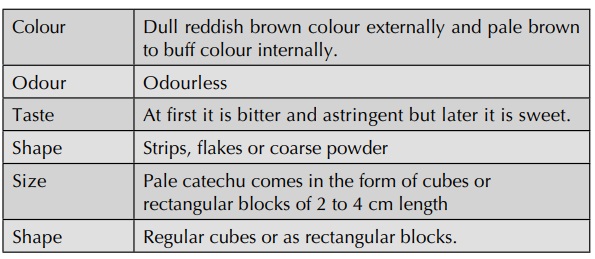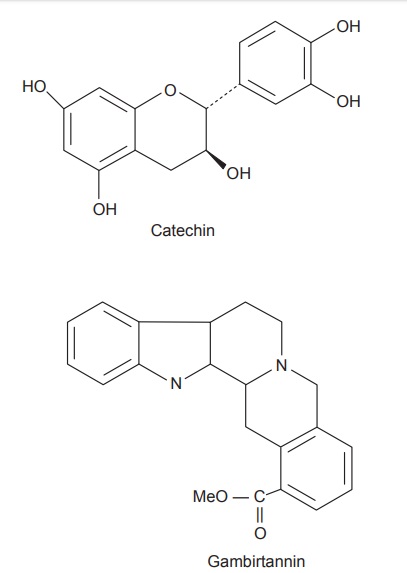Pale Catechu
| Home | | Pharmacognosy |Chapter: Pharmacognosy and Phytochemistry : Drugs Containing Tannins
Gambier or pale catechu is a dried aqueous extract produced from the leaves and young twigs of Uncaria gambier Roxburgh., belonging to family Rubiaceae.
PALE CATECHU
Synonyms
Gambier, pale catechu, catechu.
Biological Source
Gambier or pale catechu is a dried aqueous extract produced
from the leaves and young twigs of Uncaria
gambier Roxburgh., belonging to family Rubiaceae.
Geographical Source
U. gambier is a native of erstwhile Malaya. It
is cultivated in Indonesia, Malaysia,
Sumatra, Bornea, and Singapore at eleva-tion up to 150 m. The plant is used
mostly for the production of the drug, which is marketed through Singapore.
Cultivation, Collection, and Preparation
Propagation of U.
gambier is done by seeds. Seeds are sown in the nursery to raise the
seedlings, which after about 9 months are planted out in the clearing about 3
meters apart. Leaves and young shoots are collected as a first crop during
second year’s growth. Later the crop is taken every year. The plant continues
to give sufficient leaves and twigs up to 20 years, but the maximum yield is
obtained during eighth year of growth.
The collected leaves and twigs are transported to the factory
as loose material. The material is put into large drums with about three
quarters of boiling water. It is boiled for about three hours with intermittent
stirring. The marc is subsequently removed by large wooden forks and lodged on
surface to drain the liquor back to the vessels. It is pressed and washed. The
washing is added to the extract. The combined total aqueous extract is then
concentrated for one and half-hour till it becomes thick, yellowish-green
paste. It is transferred from the vessels to wooden tubs, stirred while it is
hot, and cooling in a stream of water to crystallize tannins. Semicrystallized
paste is again transferred to wooden trays in which it sets. They are cut into
cubes by wooden knife and dried in sum. The drug is also made into large blocks
in kerosene tins.
Morphology

Microscopy
The powdered drug, if mounted in the solution of
lactophenol or water, shows the small circular crystals of catechu under microscope.
The water insoluble part of the pale catechu under the microscope exhibits
epidermal pieces, unicellular hairs, cork tissues, lignified fibres, etc.
Alcohol insoluble part shows the absence of starch. The pale catechu from
Indonesia is reported to have minute starch grains.
Chemical Constituents
Pale catechu contain from about 7 to 30% of pseudotannin
catechin and 22 to 55% of a phlobatannin catechutannic acid. Both of the about
component constitute over 60% of the drug. It also contains catechu red,
gambier fluorescin and quercetin. It contains indole alkaloid up to 0.05%,
which includes gambirtannin and its derivatives. Gambirtannin gives a strong
fluorescence under UV light. Catechin forms white, needle like crystals, which
dissolves in alcohol and hot water. Catechutannic acid gives green colour with
ferric chloride.

Chemical Tests
1. Gambier
fluorescin test:
Gambier fluorescin present in pale
catechu gives the fluorescence. If to its alcohol extract, a little sodium
hydroxide is added and shaken with petroleum ether. The petroleum ether layer
shows green fluorescence. Black catechu gives negative test.
2. Vanillin-hydrochloric
acid test: Drug
shows pink or red colour with a
mixture of vanillin:alcohol:dilute HCl in the ratio 1:10:10. The reaction
produces phloroglucinol which along with vanillin gives pink or red colour.
3. A matchstick dipped in decoction of
Pale catechu is air dried and again dipped into concentrated HCl and warmed near
the burner. Pink or purple colour is produced.
4. Small quantity of powder is heated
on water bath with 5 ml chloroform and filtered. The filtrate is evaporated in
white porcelain dish on a water bath. A greenish-yellow residue is produced due
to the presence of chlorophyll in the drug. Black catechu gives this test
negative due to the absence of chlorophyll.
Uses
Pale catechu is medicinally used as local astringent. In
diarrhoea, it is used as general astringent. It is largely used in various countries
of east for chewing with betel leaf. Large proportion of gambier is used in
dyeing and tanning industries. It is used for tanning of animal hides to
convert it to leather.
